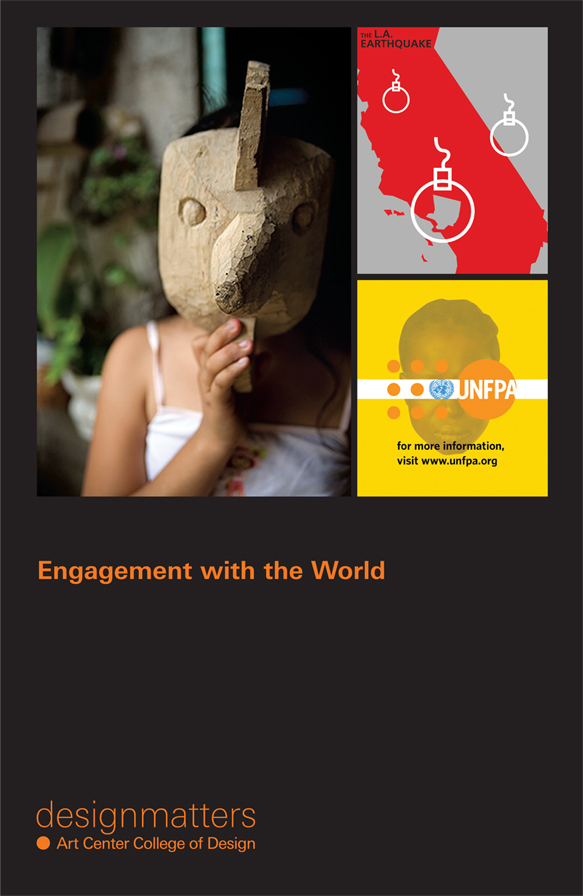David Stairs

Ball State Visual Communications student Kat Townsend documenting a hand-painted sign on a condemned house in Flint, Michigan. Photo by Laura Huffman.
Winning and losing: the dichotomy is endemic to the American way of life. From Vegas to American Idol,4 from athletic wagers to Dancing With the Stars, we take our entertainment with a grain of confrontation. In fact, in a society that qualifies most forms of advancement in terms of competitiveness, it would be unnatural to think of removing all competition from education. But, while it is most natural to expect a certain level of challenge for, say, admission to MIT or Stanford, and most schools still retain some version of the quaint tradition known as the Dean’s List, to my mind, amid all the portfolio preparation and job-jockeying that goes on, design education is increasingly defined by competition.
From the last weeks of summer onward I am bombarded with e-mail urging me to involve students in “real world” design situations. Without sounding too cynical about the practice, it seems to me that the outside solicitations of my students’ involvement are a means for organizations and/or corporations to garner spec work and public relations kudos under the guise of being good neighbors. Then again, design students are usually already pursuing some such projects. That is to say, they are not driven strictly by the friendly encounters of studio critique sessions, but are often working for on- and off-campus clients.
Some competitions, like the Society of Illustrators scholarship competition, offer money while others, like student participation in the UCDA or SIGGRAPH conferences, merely provide testimonials. A benchmark, like Print Magazine’s venerable student cover illustration issue, usually results in a portfolio piece. One recent solicitation from the Yellow Pages Association (YPA) was an attempt to enlist student entries in a display ad contest promising “nearly” $10,000 total prize monies. This may seem like a lot of cash at first glance, but when divvied up by at least 18 recipients (including students AND their faculty mentors) it doesn’t amount to much. In a different vein, students from my own program have participated in the “Creative Smackdown” sponsored by a regional studio and ad club for recruitment purposes. Aside from a brief networking opportunity, it is hard for me to see the long-term value to most of the student contestants. I’m sure it will be argued that such events hone student presentation skills, much as, UGGGH, high school speaking contests used to do, but other than serving as a vehicle for prospective employers who troll for design talent, in the end the paradigm remains unchanged. To a profession stumbling haphazardly toward self-enlightenment, see Ezio Manzini’s Changing the Change conference for instance, it would seem “competitive advantage” ought to be interpreted more broadly.
In Homo Ludens, the great Dutch anthropologist Johan Huizinga talked about the “play-element” in culture as being “primary.” In his descriptions of play and culture, the “higher forms of social play” that consist in “the orderly activity of a group or two opposed groups”, he could easily be referring to the participants of the aforementioned “Smackdown.” Drawing examples from animal life, Huizinga emphasizes that competitions and exhibitions “do not proceed from culture, they rather precede it.” It is not my intention here to try to take on the combined wisdom of observational zoology and cultural anthropology; any second-rate mind should be able to see the connection between play and education. And play is often competitive. It is merely my contention that design competitions per se are a facile pedagogical tool, and that design educators, wooed by the tempting morsels set out by industry, are overlooking obvious alternatives.
Writing in an earlier paper, Biophilia and Technophilia, that appeared in DesignIssues (Vol.13, No.3) I referred to philosopher Arnold Berleant’s “ethic of care.” Berleant is interested in community. To his mind, of the four modes of community, rational, moral, organic, and aesthetic, it is the last that generates “…a realm of inherent relationships and mutual reciprocity ruled by an ethos of interdependence.” This quote is worth repeating in my present argument because it is such an excellent example of an alternative pedagogy for design education.

A few instances exist in current design curricula, such as Stanley Tigerman’s Archeworks, which has been addressing urban problems through its unique one-year post-graduate projects for over a decade, or Art Center’s oft-cited Designmatters program. Mariana Amatullo, Director of Designmatters says, “…we do have a substantially broad scope within the thematic framework of Designmatters (human sustainable development, global health, social entrepreneurship, public policy) because not designing for, but designing with, is one of my main priorities as we take on increasingly complex projects and partnerships.” A recent project in Laikipia, Kenya which sought to develop a transport/packing system for camel convoys carrying medicine to outlying communities will be field-tested in Ethiopia next month. Although alumni were able to visit the project location to do preliminary field research, the program was not able to send students abroad to develop a series of visually-based health education materials for HIV-AIDS awareness and family planning.
Ironically, although Amatullo says “typically we do not enter competitions,” the Laikipia project grew out of a World Bank Development contest entry (unfunded, but one of the top 100 entries out of 3000 worldwide). According to Amatullo: “We try to build a very participatory framework, and we have developed a methodology of checks-and-balances at key junctures of the project’s development as well as many opportunities for the design team (faculty, students and partner organizations) to dialogue. This hopefully creates in the studio an atmosphere of self-examination and self-evaluation—a constant reality check of sorts.” Programs like Designmatters, though few and far between, are spreading. They take valuable steps toward producing better-rounded, more worldly, cross-culturated students.

Ball State CapAsia architecture students and local villagers dig house foundation’s in Kalametiya, Sri Lanka, a post-tsunami relocation project
Professor Wes Janz, who teaches architecture at Ball State University in Muncie has a more guerilla-like approach. Janz, who in 2006 conducted his students on a “Midwess Distress Tour” of Gary, Indiana, East St. Louis, Missouri, and Flint, Michigan says, “Competitions…and we’re having them all the time now within our Department of Architecture… are moments to challenge the students (and ourselves) to be professional, to “solve” “real” “problems,” to do buildings, to keep ourselves focused on what all of our students want, which I guess is to be architects.” If this list of clichés seems rehearsed, it could be because Janz is critical of the profession. He sees architecture as a “minor profession,” unlike medicine or law, struggling with diversified curricula and contested efforts to “codify” professional practices. Architecture programs become tangled in webs of AIA accreditation hurdles and outside interests vying for “…low paid employees who don’t need much training,” with the outside interests often being the originating program’s own alumni.
Janz, who “…still tries to blow these competitions up,” took his masters students to the California border fence and maquiladora zone of northern Mexico, as well as exposing them to a series of hand-picked guest lecturers last fall. Janz is, “…a little more after a civic/social point of view, and …interested in keeping such perspectives in play (while) challenging the profession and professionals to be more, to imagine more for themselves.” As a result of the emphasis on competition Janz says, “. . . the university shifts from being a place of thought and questions and discussions to a training school. We move from being an architectural school to being an architect school, from a school of architecture to a school of architects. There’s a big difference.” Janz’ efforts represent a good instance of the merits of teaching students to cooperate and care rather than compete and conform. The rewards are less immediate than the ego boost resulting from a contest win but, in the long run, imparting a sense of cooperation and an understanding that not all professional goals can fall under the “for profit” rubric should rank as two of the highest aims for design education.

Border fence, photographed by Ball State student Breanna Gary in February 2007
I don’t think one can look anytime soon for a decline in the practice of open competition in the commercial design profession, and this will likely be the main argument for preparing students to compete. Then again, the digital revolution has given business and industry unprecedented influence over design program curricular development. While design educators wrangle over the best methods for teaching students how to think, their programs continue to act as feeders of generation after uniform generation of software savvy technicians to industry.
Design education as good citizenship makes more sense. Since we are united as a community, design education itself can and should be applied as an object lesson in civics. Moholy-Nagy put it well in Vision In Motion, “A social goal can incite most valuable qualities in young people, unselfishness and devotion to a task even if the work does not promise a specific reward. But only when all interests are focused on social justice and social harmony will the essential role of the individual be secured in the realization.”
We must look beyond education for personal, or even professional gain, recognizing that interrelationships are not only the ties that bind, but the ones that also humanize us.
David Stairs is the founding editor of Design-Altruism-Project











May 19, 2008 at 12:52 pm
To quote Saint Exupery, “In anything at all, perfection is finally attained not when
there is no longer anything to add, but when there is no longer anything to take away.”